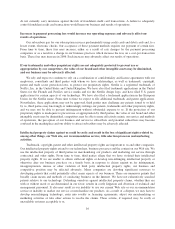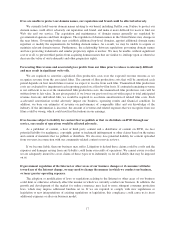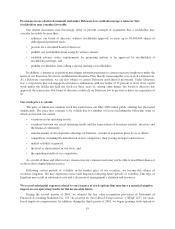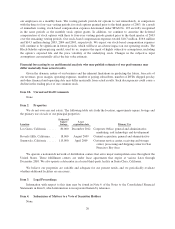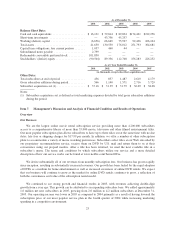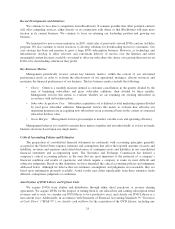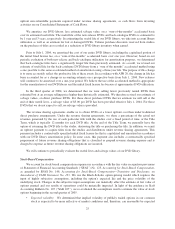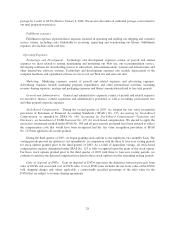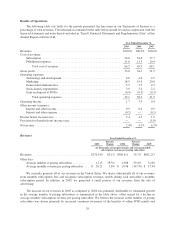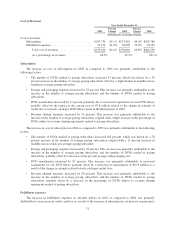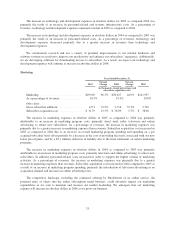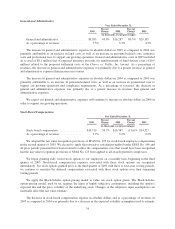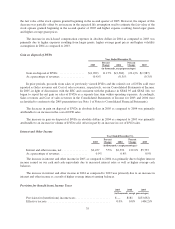NetFlix 2005 Annual Report Download - page 41
Download and view the complete annual report
Please find page 41 of the 2005 NetFlix annual report below. You can navigate through the pages in the report by either clicking on the pages listed below, or by using the keyword search tool below to find specific information within the annual report.upfront non-refundable payments required under revenue sharing agreements, as cash flows from investing
activities on our Consolidated Statements of Cash Flows.
We amortize our DVD library, less estimated salvage value, on a “sum-of-the-months” accelerated basis
over its estimated useful life. The useful life of the new-release DVDs and back-catalogue DVDs is estimated to
be 1 year and 3 years, respectively. In estimating the useful life of our DVD library, we take into account library
utilization as well as an estimate for lost or damaged DVDs. Volume purchase discounts received from studios
on the purchase of titles are recorded as a reduction of DVD library inventory when earned.
Prior to July 1, 2004, we amortized the cost of our entire DVD library, including the capitalized portion of
the initial fixed license fee, on a “sum-of-the-months” accelerated basis over one year. However, based on our
periodic evaluation of both new release and back-catalogue utilization for amortization purposes, we determined
that back-catalogue titles have a significantly longer life than previously estimated. As a result, we revised our
estimate of useful life for the back-catalogue DVD library from a “sum of the months” accelerated method using
a one-year life to the same accelerated method of amortization using a three-year life. The purpose of this change
is to more accurately reflect the productive life of these assets. In accordance with APB 20, the change in life has
been accounted for as a change in accounting estimate on a prospective basis from July 1, 2004. New releases
will continue to be amortized over a one-year period. We believe the use of the accelerated method is appropriate
for the amortization of our DVD library and the initial fixed license fee because it approximates DVD utilization.
In the third quarter of 2004, we determined that we were selling fewer previously rented DVDs than
estimated but at an average selling price higher than historically estimated. We therefore revised our estimate of
salvage values, on direct purchase DVDs. For those direct purchase DVDs that we estimate we will sell at the
end of their useful lives, a salvage value of $3.00 per DVD has been provided effective July 1, 2004. For those
DVDs that we do not expect to sell, no salvage value is provided.
The revenue sharing agreements enable us to obtain DVDs at a lower upfront cost than under traditional
direct purchase arrangements. Under the revenue sharing agreements, we share a percentage of the actual net
revenues generated by the use of each particular title with the studios over a fixed period of time, or the Title
Term, which is typically 12 months for each DVD title. At the end of the Title Term, we generally have the
option of returning the DVD title to the studio, destroying the title or purchasing the title. In addition, we remit
an upfront payment to acquire titles from the studios and distributors under revenue sharing agreements. This
payment includes a contractually specified initial fixed license fee that is capitalized and amortized in accordance
with our DVD library amortization policy. In some cases, this payment also includes a contractually specified
prepayment of future revenue sharing obligations that is classified as prepaid revenue sharing expense and is
charged to expense as future revenue sharing obligations are incurred.
We will continue to periodically evaluate the useful lives and salvage values of our DVD library.
Stock-Based Compensation
We account for stock-based compensation expenses in accordance with the fair value recognition provisions
of Statement of Financial Accounting Standards (“SFAS”) No. 123, Accounting for Stock-Based Compensation,
as amended by SFAS No. 148, Accounting for Stock-Based Compensation—Transition and Disclosure, an
Amendment of FASB Statement No. 123. We use the Black-Scholes option-pricing model which requires the
input of highly subjective assumptions, including the option’s expected life and the price volatility of the
underlying stock. Changes in the subjective input assumptions can materially affect the estimate of fair value of
options granted and our results of operations could be materially impacted. In light of the guidance in Staff
Accounting Bulletin No. 107 (“SAB 107”), we re-evaluated the assumptions used to estimate the value of stock
options beginning in the second quarter of 2005.
•Expected volatility: We determined that implied volatility of publicly traded options in our common
stock is expected to be more reflective of market conditions and, therefore, can reasonably be expected
25



